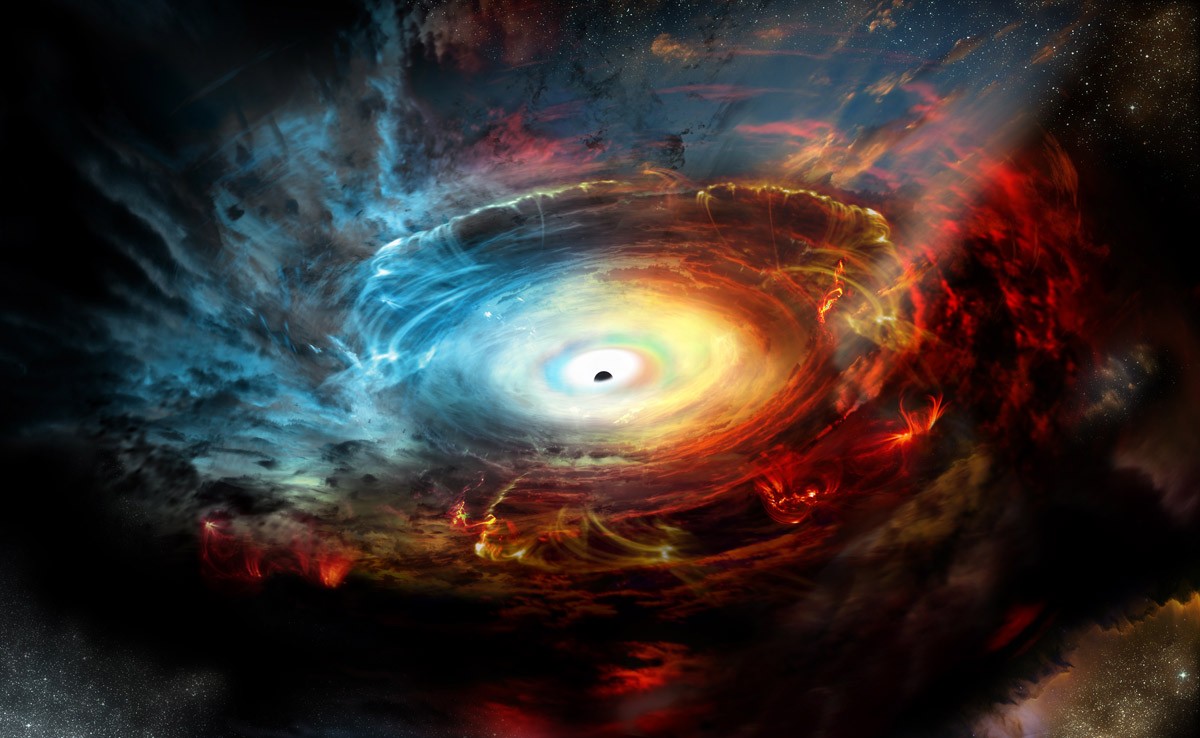
Artist impression of the heart of galaxy NGC 1068. // Credit: NRAO/AUI/NSF; D. Berry / Skyworks
Black hole hidden within its own exhaust
Supermassive black holes, millions to billions of times the mass of our Sun, are found at the centers of galaxies. Many of these galactic behemoths are hidden within a thick donut-shaped ring of dust and gas known as a torus. Previous observations suggest these cloaking, tire-like structures are formed from the material found near the center of the galaxies.
NGC 1068 is a barred spiral galaxy approximately 47 million light-years from Earth in the direction of the constellation Cetus. New data from the Atacama Large Millimeter/submillimeter Array (ALMA), however, reveals that the black hole at the center of the NGC 1068 is actually the source of its own dusty torus of dust and gas, forged from material flung out of the black hole’s accretion disk. This newly discovered cosmic fountain of cold gas and dust could reshape our understanding of how black holes impact their host galaxy and potentially the intergalactic medium.
“Think of a black hole as an engine. It’s fueled by material falling in on it from a flattened disk of dust and gas. But like any engine, a black hole can also emit exhaust,” said Jack Gallimore, an astronomer at Bucknell University in Lewisburg, Pennsylvania, and lead author on a paper published in Astrophysical Journal Letters.
In the 90’s, Gallimore was a graduate student of U of M astronomers Stefi Baum and Chris O’Dea, and did his PhD research on NGC 1068. Gallimore was at the University of Maryland while Baum and O’Dea were with the Space Telescope Science Institute at the time. Together, they published a series of papers in the mid 1990s which served as the forerunners of this new discovery.
Astronomers discovered the exhaust from NGC 1068 is the likely source of the torus of material that effectively obscures the region around the galaxy’s supermassive black hole.
Using ALMA, Gallimore, Baum and others from an international team of astronomers peered deep into this region and discovered a sprinkling of cool clouds of carbon monoxide lifting off the outer portion of the accretion disk. The energy from the hot inner disk partially ionizes these clouds, enabling them to adhere to powerful magnetic field lines that wrap around the disk.
Like water being flung out of a rapidly rotating garden sprinkler, the clouds rising above the accretion disk get accelerated centrifugally along the magnetic field lines to very high speeds―approximately 400 to 800 kilometers per second (nearly 2 million miles per hour). This is up to nearly three times faster than the rotational speed of the accretion disk itself, fast enough to send the clouds hurtling further out into the galaxy.
Time for a rethink?
“These clouds are traveling so fast that they reach ‘escape velocity’ and are jettisoned in a cone-like spray from both sides of the disk,” said Gallimore. “With ALMA, we can for the first time see that it is the gas that is thrown out that hides the black hole, not the gas falling in.” This suggests that the general theory of an active black hole is oversimplified, he concludes.
Said Baum, “Back in 1997 we published a paper in Nature which reported the first discovery of radio emissions from hot electrons in the inner edge of the torus in NGC 1068. The new ALMA observations report data from the same torus in NGC 1068 in a different part of the electromagnetic spectrum, allowing us to detect dusty clouds of molecular gas in the torus.”
“Our new ALMA data reveals that there are gas clouds which are both orbiting the black hole – in a torus – as well as being expelled in a wind. This is a more complex, more dynamic picture than had been previously envisaged.”
With future ALMA observations, the astronomers hope to work out a fuel budget for this black hole engine: how much mass per year goes into the black hole and how much is ejected as exhaust.
“These are fundamental quantities for understanding black holes that we really don’t have a good handle on at this time,” says Gallimore.
Research at the University of Manitoba is partially supported by funding from the Government of Canada Research Support Fund.







